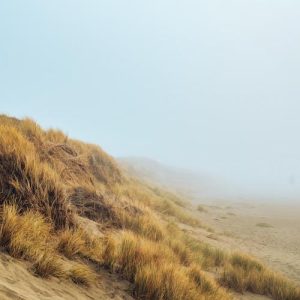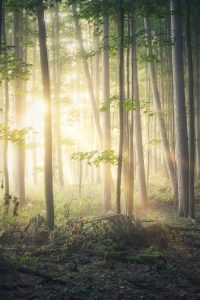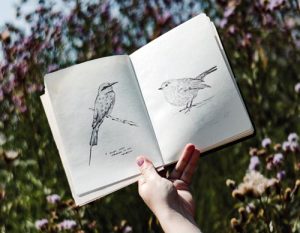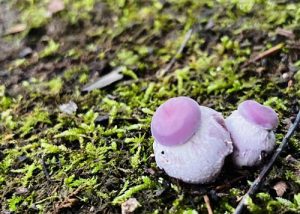Bathe in a Forest, Listen to the Grass
Lessons from Rachel Carson on reconnecting with the wonders around us.
At 8:00 a.m. rush hour, the bustle of cramped sidewalks mirrors my internal environment. Coupled with navigating new illness and the general feeling of decomposing, a hectic start to the semester has left me frayed. But today I head for a winding trail. The image of an abandoned grassy swath at the end is seductive and propels me through the smog.
I trek a hill of white-capped grass that glistens in sunlight. The ground sings with the crush of frost. At the summit, clear air fills me and the fragmented feeling drips away with the liquid streaming from my nose. Words from Rachel Carson’s Silent Spring come to mind:
“Those who contemplate the beauty of the earth find reserves of strength that will endure as long as life lasts. There is something infinitely healing in the repeated refrains of nature — the assurance that dawn comes after night, and spring after winter.”
Carson knew the value of connecting to the wonder of the world around us. Studies show that exposure to nature decreases stress, anxiety, and depression, lowers blood pressure, bolsters the
immune system, and generally enhances mood. Spending time in natural spaces even increases the brain’s capacity to learn and feel empathy. As Carson so eloquently said:
“The more clearly we can focus our attention on the wonders and realities of the universe about us the less taste we shall have for the destruction of our race. Wonder and humility are wholesome emotions, and they do not exist side by side with a lust for destruction.”
Speech accepting the John Burroughs Medal
Humans evolved to flourish and build community when connected to their environment, particularly when we take the time to observe the vibrant, breathing Earth. Alienation from nature adversely affects development and can lead to the increased stress and sense of anomie I was feeling saturated in the city’s hustle. There’s even a term for the negative effects of an absence of nature: Nature Deficit Disorder. A remedy? Get outside and observe the world around you with intentionality. While simply strolling outdoors or soaking up some sun can help you feel more connected and present, here I challenge you to try at least one of these five specific activities inspired by Rachel Carson.
1. Sky Watch
When developing the smartphone app “Urban Mind”, researchers found that looking up at the sky brings many benefits of nature exposure. Whether a few breaths between lunch and your next shift or a planned night atop a hill to peer into the universe, skywatching is a practice feasible anyplace we have a glimpse of the world above. Find a break between buildings or lie in the grass. Focus on the colors and textures of the clouds. How do they drift today? Who and what are you sharing the space with, and might they have their gaze upturned as well?
2. Forest Bathe
Developed in the late 1900s in response to Japan’s increasingly urbanized and digitized reality, shinrin-yoku, or forest bathing, is a practice that involves mindful immersion in a natural space like a forest. Forest bathing not only reduces stress, heightens focus, and fosters a deeper connection to the world, but flora may literally imbue your body with strength and healing. The air of a forest brims with phytoncides, compounds trees release to deter pests and fight disease.
Some phytoncides act as antimicrobials in the body, while others enhance immune system functioning, serve as anti-inflammatories, or increase sleep and rest-inducing hormones while lowering cortisol levels.
Leave distractions like your phone. Find a wooded area to wander, then still. Concentrate on each blossoming perception. Intentional breath, movement, and awareness are vital to receive the full benefits of forest bathing. How does the air taste? Can you hear the beetle lumbering through crunchy leaves? Does sunlight tingle your skin, cold invigorate and raise chills? Allow the sensations of the forest to lap over your body like waves.
3. Keep a “Places” Journal
Choose a location outside and visit it as often as possible for a week. After several minutes of silent stillness observing the life and processes around you, write or draw whatever comes. Include descriptions of sensations, imagery, and other physical observations; additionally, record emotions and more creative interpretations that the place inspires. Forget proper sentence structure or aesthetics — your “place” journal is your own, not to be shared.
While it can be good practice to journal about the many places you encounter, it is equally useful to write how you experience one place over time — this not only allows you to witness the constant flux of the environment, but coming to know a place deeply can imbue a sense of rootedness and provide a memorized landscape to visit when pressures of the workday pile up.
4. Learn a Plant or Animal Intimately
Knowing a place brings a host of benefits, but delving into the life of a specific organism can also help you feel more connected to the world around you and serve as an exploration into your own life. Many plants can be observed day after day; more mobile organisms are a bit trickier, but it is possible to find a species of habit. How do these creatures spend their lives? In what ways do they interact with the world, with you? Dig deeper — spend a few moments each day researching your organism until you feel you could excite a room of unenthused first graders with the life and biology of this being.
5. Find wonder through “what if?”
Our last activity comes directly from Rachel Carson:
“For most of us, knowledge of our world comes largely through sight, yet we look about with such unseeing eyes that we are partially blind. One way to open your eyes to unnoticed beauty is to ask yourself, “What if I had never seen this before? What if I knew I would never see it again?” (Carson, The Sense of Wonder)
I find this exercise useful in both landscapes of great beauty, as well as grimy, less-placid urban environments. It humbles me and reminds me that wonder is found within the simplest of things if we explore with child-like curiosity. “What if I had never seen this before? What if I knew I would never see it again?” Reframe the question for all of your senses.
I hope the activities outlined here inspire you to explore and marvel at the wonders of nature. The story of the earth, and thereby the story of humanity, is held in the places around us — each cedar-capped outcropping, sandy swale shaped by tides, and spring-fed forest has strength to infuse and wisdom to share if we dare listen deep enough.
 RCC Fellow — Willow Gatewood — Catawba College
RCC Fellow — Willow Gatewood — Catawba College
RCC Fellow Willow Gatewood is a senior at Catawba College studying Environment and Sustainability, with minors in Creative Writing and GIS. She is also an intern and work-study for the Catawba College Center for the Environment and involved in environmental and climate advocacy groups.
![]() The Rachel Carson Council depends on tax-deductible gifts from concerned individuals like you. Please help if you can.
The Rachel Carson Council depends on tax-deductible gifts from concerned individuals like you. Please help if you can.
![]() Sign up here to receive the RCC E-News and other RCC newsletters, information and alerts.
Sign up here to receive the RCC E-News and other RCC newsletters, information and alerts.












